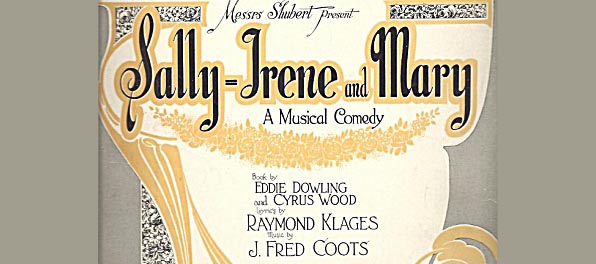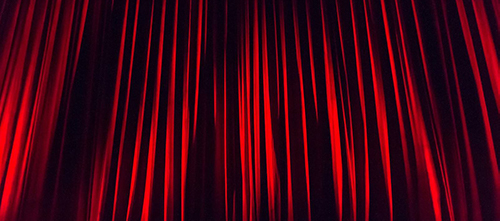Pas de biographie disponible.
Compositeur Musique additionelle Librettiste Parolier Metteur en scène Chorégraphe Producteur création Producteur version

Musical
Musique: J. Fred Coots • Paroles: Raymond Klages • Livret: Cyrus Wood • Edddie Dowling • Production originale: 4 versions mentionnées
Dispo: Résumé Génèse Liste chansons
Genèse: Dans une saison en pleine surchauffe de ‘Cendrillon-musicals’, «Sally, Irene et Mary» ont triplé l’enjeux en offrant l’histoire de trois jeunes irlandaise new-yorkaises qui passent de la pauvreté à la richesse. Bien que nos héroïnes n’étaient pas directement liées aux héroïnes des musicals à succès Irene (1919), Sally (1920) et Mary (1920), elles étaient clairement leurs sœurs d’âme avec des rêves de gloire dans le show business et de riches maris. Et le nouveau musical n’a pas déçu le public, qui en a fait un succès tenant l’affiche plus de 300 représentations. Il est devenu le troisième plus gros succès de la saison. Le spectacle était basé sur un court sketch de vaudeville qu’Eddie Dowling avait écrit pour l’un des projets des Shuberts de la saison précédente. Dowling (qui a également joué dans le musical) et Cyrus Wood ont retravaillé le projet en musical à part entière avec des paroles de Raymond Klages et de la musique de J. Fred Coots.
Résumé: Nous rencontrons d’abord Sally (Jean Brown), Irene (Kitty Flynn), et Mary (Edna Morn) alors qu’elles passent leurs journées sur les trottoirs devant leurs immeubles de l’avenue A. Le destin a voulu qu’un imprésario de Broadway repère Mary et lui offre un emploi à Broadway, et quand Sally et Irene demandent à pouvoir aussi tenter leur chance sur la Great White Way, il les engage rapidement également. Le trio suit vite le trajet vers la gloire à Broadway, et quatre ans plus tard, elles sont les coqueluches de la ville. En fait, toutes les trois jouent dans leurs propres spectacles au Vanderbilt, Knickerbocker, et New Amsterdam Theatres (où les productions originales respectives d’Irene, Mary et Sally avaient ouvert) qui, grâce à la magie des musicals, se situaient dans la même rue (même dans la réalité ces théâtres étaient situés respectivement sur les 48e, 38e et 42e rues).
Création: 4/9/1922 - Casino Theatre (Bway) (Broadway) - 313 représ.

Musical
Musique: J. Fred Coots • Paroles: Al Dubin • Dolph Singer • Livret: Leo Donnelly • Paul Gerard Smith • Production originale: 1 version mentionnée
Dispo: Génèse Liste chansons
Genèse: In theme and presentation (but not in quality), the critics compared White Lights (a self-described “unique musical comedy of Broadway”) to such recent nonmusical hits as Broadway (1926) and Burlesque (1927), and even to the recent flop Footlights. But not for an instant did anyone think White Lights was unique, and it quickly joined the season’s parade of fast-folding failures. The story looked at the world of nightclubs and Broadway, and the New York Times noted there wasn’t any “novelty” in the show’s clichéd characters: the blonde singer Polly, aka Jean Paige (Marian Marschante, who during the short run was succeeded by Gertrude Lang, who a month earlier had played the leading lady Babette in the flop Half a Widow) is from a good family and doesn’t belong in “this kind” of work; the “noble-hearted youth” Danny Miles (Sam Ash, who was succeeded by Sam Wren) is in love with Polly and is “God’s gift to the songwriting business”; the nightclub hostess Flossie Finch (Rosalie Claire) has what is “technically known as a heart of gold” about “two feet below her auburn tresses”; and a butter-and-egg man has lustful designs on Polly and is all too willing to help her up the ladder of show-business glory. So, the moneyman backs a big Broadway show that stars Polly, and during the premiere she collapses when she realizes Danny is in the audience and has heard her perform a “sacred” number he had written for her and her alone, one never intended for anyone’s ears but hers. But the Times reported that a brief coda “let it be known that everything’s going to be all right.” In many respects the evening was a series of presentational numbers rather than plot or character songs. There were seven unnamed specialty acts, and the Times indicated that at one point in the first act the action halted and gave way to a twenty-minute floor show at the nightclub The Monastery, which included dancers, contortionists, and “ballad and wah-wah singers.” And the second act depicted both rehearsal scenes for a Broadway musical and scenes from that musical during its opening night performance. H.H. in Brooklyn Life and Activities of Long Island Society cautioned that “everything” in the production “reminds one of something one has heard or seen before,” and the music was “undistinguishable from the tunes associated with innumerable undistinguished musical shows.” But Marschante was “certainly very pretty, even if her coyness is somewhat forced,” and Claire could “sling slang and swear like the army in Flanders, and she does it very thoroughly.” The Brooklyn Daily Eagle noted that “you might want to see White Lights,” and warned that if you did “you had better hurry before the moving van backs up.”
Résumé:
Création: 11/10/1927 - Walter Kerr Theatre (Broadway) - représ.